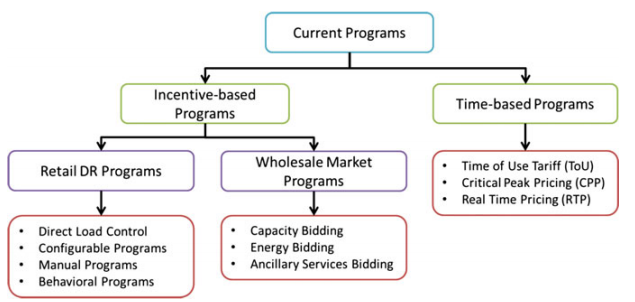The existing DR programs can be mainly categorized as time-based programs and incentive-based programs. There are currently 10 program types, 3 of which are time-based and the remaining 7 are incentive-based.
Note: This content is related to a scientific publication. For citing in your studies, please refer to the book chapter:
M.A. Zehir, M. Bagriyanik (2018), “Distribution Network Oriented Demand Response,” In: Arefi A., Shahnia F., Ledwich G. (eds) Electric Distribution Network Management and Control. Power Systems. Springer, Singapore.
doi: 10.1007/978-981-10-7001-3_5

Time-Based Programs
In time-based programs, changes in daily market prices and main trends to maintain supply-demand balance are indirectly reflected to prices of different time periods. In response to changes in electricity pricing rates, the consumers are expected to make
changes in their consumption and ease supply/demand balancing efforts.
- Time of Use (ToU) Tariff
In this tariff structure, the day is divided into a number of periods. The most basic
ToU tariff include two periods namely peak and off-peak. Electricity prices for each
period are announced well in advance and they are rarely updated more than a
couple of times annually. There are also some other ToU types with more pricing
periods. - Critical Peak Pricing (CPP) Tariff
CPP is based on application of a high price during critical peak times that occur for
short periods in a year. It can be applied either individually or together with a ToU
tariff. Unlike ToU, the time periods in which a high price will be applied are not
known before they occur. - Real Time Pricing (RTP) Tariff
In RTP, hourly wholesale market-clearing prices are proportionally reflected to
customers in real time. There are three diversified applications of RTP. In
day-ahead RTP, the hourly prices of the next day are determined and announced to
the customers; while in intraday RTP, the prices are available just a couple of hours
prior to the related hour. In the last type, a demand reference profile is defined
for customers and consumptions covering both under and above of that profile are
priced expensively. Due to hourly varying dynamic prices, RTP tariffs require
advanced communication and automation infrastructures to be effectively deployed.
Incentive-Based Retail Programs
Time-based programs have limited flexibility, due to their certain operation cycles
and predetermined rates. For more effective use of DR in grid operation, a number
of incentive-based programs have been developed. These programs usually reward
customers using incentives based on the event content (duration, targeted amount of
demand management) and participator performance (achieving the requested
change in demand for the related period). There are also some programs in which
the incentives are paid upon the acceptance of participation or authorization of a
remote demand managing entity.
- Direct Load Control (DLC)
DLC is based on remote dispatch of manageable loads by an operator through radio
signal, internet and etc. The distinctive part of this program is that, device owners can make further changes in control settings to allow or restrict the actions. - Manual Programs
These programs are based on manual control of devices by their owners according
to event notifications. Events can be announced using a home energy management
device, SMS, e-mail, social media accounts, mobile phone application or web
application. Manual programs are not popular except places where the consumers
are automatically subscribed. - Behavioral Programs
These programs aim to socially motivate consumers to make changes in their
consumption behavior without providing any monetary incentives. Behavioral
programs usually use weekly/monthly reports, real-time feedback using in-home
display and e-mail messages to promote energy management.
Incentive-Based Wholesale Market Programs
The programs that are conducted by the system operator and regulatory organizations
are categorized under this title. Achievable benefits generally depend on market-clearing prices and demand response success.
- Capacity Bidding
It is based on the manageable power that will be used, when power grid operational
limits have the risk of being violated. Up on the confirmation to provide this
service, a prepayment is settled. If the promised amount of demand reduction is not
achieved during an event, the participators are penalized. - Energy Bidding
The customers can either directly (mostly industrial customers) or indirectly participate
(rather residential and commercial) in the energy market through their bids. The conventional type is day-ahead market, while intraday markets are also
established at the further stages of grid modernization. - Ancillary Services Bidding
The reserve bids are in this program. A prepayment is offered after placing a
contract. This service type requires frequent dispatch of fast responding devices for
short durations of time, offering rather higher incentives compared to other
market-driven programs.
For futher reading about DR programs:
- M.A. Zehir, M. Bagriyanik (2018), “Distribution Network Oriented Demand Response,” In: Arefi A., Shahnia F., Ledwich G. (eds) Electric Distribution Network Management and Control. Power Systems. Springer, Singapore.
doi: 10.1007/978-981-10-7001-3_5
